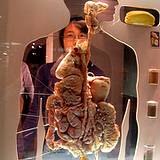|
Grandma's Human Digestive System
|
 |  |  |
The process of the human digestive systems actually begins when you simply think about eating or smell the aroma of something you want. The digestive system is the means by which the body transforms food into the energy it needs to build, repair and fuel itself. On average, an adult body processes roughly 2 ½ gallons of digested food, liquids and digested secretions each day.
As food enters the mouth, salivary glands mix special chemicals with each bite to make further digestion easier. Click on this link to read about digestive enzymes and the importance of taking enzyme supplements, especially as we age.
The tongue has nerves that relay to the rest of the digestive system what's on the way down. For a normal person, what tastes or smells particularly good may be what the body has a strong need for at that time--fruits for quick energy, vegetables for calming endurance, and grains for protein to replace tissue or for more growth.
When the body starts to age, the human digestive system tires and slows down, especially under stress. Stomach levels or hydrochloric acid (HCI) are too low for almost everyone older than 55. HCI is needed to digest proteins, and is the only desirable inorganic acid found in the body. This acid not only digests proteins it also helps dissolve needed minerals like calcium. Click on this link to learn about the importance of Amino Acids and the role they play in your digestive health.
Emotional over-stimulation tends to increase HCI in the stomach, causing heartburn---acid indigestion-in some people. With time, this important acid may be depleted especially in those taking antacids, and the whole body begins to suffer from malnutrition, even with a good diet!
Powerful drug antihistamines or nutritional insufficiencies may cause the mucus tissue on the wall of the stomach to recede or disappear, exposing the stomach lining to self-digestion, the ultimate ulcer!
Amazing Journey Through
The Human Digestive System
After food has been preprocessed in the stomach, it is gradually passed through a sphincter valve, at the bottom of the stomach, into the small intestine for finishing and absorption.
It is here that the pancreas and liver add their own digestive fluids to the mix, along with those of the gall bladder, which only processes fats and oils.

Just inside the small intestine, the strong HCI of the stomach is neutralized so that enzymes requiring an alkaline environment can take over.
Powerful muscular contractions mix the food with digestive juices and push it long the intestinal wall. Thousands of absorptive structures lining these walls (called villi) contain a dense capillary network that transports the processed food to large blood vessels. As a finished product, each nutrient can now pass through the intestinal wall into the bloodstream to be transported first to the liver for final inspection.
Back in the small intestine, millions of friendly bacteria have the capacity of taking food that you manufacture and change them into certain vitamins and minerals. Different bacteria live in different portions of both the large and small intestine. They perform specific healthful functions. In the wrong place, however, they can become your enemy and cause inflammation and infections that attack bowel tissue and poison the bloodstream. To keep them under control, acidophilus bacteria as one example, keeps harmful bacteria and fungus at bay. Maintaining a healthy bacteria population, therefore, requires a healthful lifestyle.
After most of the nutrients have been absorbed, the residue bulks up in the large intestine. Here, water is reclaimed before the stool is expelled from the body.
Major Parts of the Digestive System
- Oral cavity - mouth, teeth, tongue and salivary glands.
- Esophagus - a muscular tube that moves food to the stomach.
- Stomach - mixes food with HCI, breaks it down and moves it on.
- Liver - has over 500 functions, including providing digestive enzymes, and inspecting nutrients for safety before they enter the bloodstream for general circulation.
- Gall Bladder - stores bile made in the liver that breaks down fat.
- Pancreas - secretes digestive enzymes and insulin to regulate blood sugar.
- Small Intestine - receives food from stomach, finishes digestion, and absorbs nutrients into bloodstream.
- The human digestive system consists of the stomach, intestines, liver, and gallbladder.
- The human digestive system's main function is to break down food so the food can be absorbed by the body.
- Your stomach reflects your mood, when you turn red your stomach turns red. Turn pale and it turns pale. Get excited, your stomach speed up its contractions. When you are depressed, your stomach muscular waves and acid secretions slow down dramatically, making your food harder to digest.
- According to the National Digestive Disease Board, approximately 13 percent of all admissions to general hospitals and 10 percent of all surgeries are for the treatment f digestive diseases.
- Your stomach can heal a scratch from a sharp food (like a fish bone) in 24 hours, on the other hand, the skin would take a week to heal the same thing.
- Water and sugars are absorbed directly into the blood stream from the stomach. Fats, starches and proteins complete digestion in the small intestines.
- The presence of food in the esophagus stimulates peristalsis rhythmic contractions that move food through the digestive tract.
- Soluble dietary fiber, which absorbs water, forms bulk in the stomach and creates a feeling of fullness and satisfaction.
- It takes from two to six hours for food to empty from the stomach into the small intestine.
- The small intestine is about 23 feet long.
- About 95 percent of all nutrient absorption takes place in the small intestine.
Interesting Facts About the Digestive System
DID YOU KNOW?
Return from The Human Digestive System Guide to Grandma's Herbal Remedies Home





